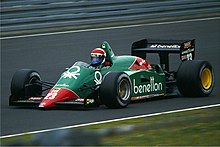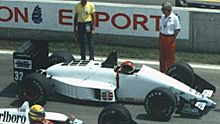Euroracing
Euroracing was a motorsport team based in Senago , northern Italy , which participated in Formula 3 , Formula 3000 and Formula 1 in the 1970s and 1980s . In Formula 1, Euroracing was initially associated with the Italian car manufacturer Alfa Romeo ; later it was temporarily involved in the EuroBrun Racing team .
The founder of the team was the Italian businessman Gianpaolo Pavanello (according to other sources: Paolo Pavanello), who represented the racing car manufacturer March on the Italian market and sold its cars in Italy since the early 1970s . In the mid-1970s, Pavanello founded his own team, called Euroracing, which he first started in the Italian Formula 3 and later also in the Formula 3 European Championship. Euroracing mostly used current vehicles from March, which were powered by Alfa Romeo engines. The racing team was able to achieve numerous successes in Formula 3 and soon became the dominant team in this class. In the higher racing classes, however, Pavanello's engagement was not crowned with success.
Euroracing in Formula 3
Euroracing was successful in Formula 3 on both a national and a European level. In 1977 Piercarlo Ghinzani was able to win the Italian Formula 3 championship in a Euroracing March; his team-mate Michele Alboreto finished second. In 1980 Alboreto became Formula 3 European Champion with Euroracing, a year later Mauro Baldi repeated this success.
At the beginning of the 1982 Formula 3 season, Euroracing became a racing car manufacturer. The trigger for this step was the fact that March had discontinued his Formula 3 program at the end of 1981. In order to be able to compete in the Formula 3 European Championship with current vehicles in 1982, Euroracing developed its own car, the Euroracing 101. The car was based on March 813; however, the British design had been revised by the former Ferrari engineer Gianni Marelli on Pavanello's order. The cars powered by Alfa engines were very successful. The Euroracing driver Oscar Larrauri was European Formula 3 champion in 1982, his teammate came second. Both pilots won 15 out of 30 races that year.
At the end of the 1982 season, Euroracing ended its involvement in Formula 3. One of the cars was sold to Carlo Brambilla , the son of Formula 1 racing driver Vittorio Brambilla , who used it privately with little success.
Between 1983 and 1985, Euroracing was involved in Formula 1 in collaboration with Alfa Romeo . After this project ended, Euroracing returned to Italian Formula 3 in 1986.
Euroracing in Formula 3000
At the beginning of 1987, Euroracing merged with the Italian rival Venturini team. The team, now known as Euroventurini , entered the Formula 3000 in 1987 without success. The team used a vehicle developed and built by Dallara . The Dallara 3087 was the first racing car that the Italian racing car manufacturer had designed for a class above Formula 3. It turned out to be unsuccessful.
Euroventurini reported two vehicles in the 1987 Formula 3000 season. A 3087 was driven by Marco Apicella in all races of the season . He only finished in the points once when he finished fifth in the race at Spa-Francorchamps. The second car was driven in succession by Jari Nurminen , Guido Daccò and Nicola Tesini . None of the three pilots could win a championship point. At the end of the season, Euroventurini gave up its Formula 3000 commitment. The Dallara cars were sold to the rival team Forti Corse and there in 1988 ; Another car found its way into Formula 1 temporarily through the BMS Scuderia Italia team .
Euroracing in Formula 1
Euroracing was involved in Formula 1 with two different projects between 1983 and 1988.
1983 to 1985: Alfa Romeo
The Italian car manufacturer Alfa Romeo, which had competed in Formula 1 with its own factory team organized by Autodelta since 1979 , found itself in a serious financial crisis in the early 1980s. In order to reduce running costs, Alfa Romeo's management decided in autumn 1982 to end the factory Formula 1 involvement at the end of the season. In order to allow the name Alfa Romeo to continue to appear in Formula 1, the racing operations were to be transferred to an independent racing team that, with the technical support of Autodelta, would bring the Milan cars to the start in the future. The choice fell on the Euroracing team, which had attracted attention in recent years for its success in Formula 3. Euroracing was authorized to report the vehicles under the name Alfa Romeo. For the 1983 Formula 1 season, the team used the Alfa Romeo 183T developed by Autodelta ; the later vehicles were developed by Euroracing itself - albeit with the support of Alfa Romeo.
The connection between Euroracing and Alfa Romeo lasted from 1983 to 1985 . Although Euroracing temporarily had highly qualified staff such as Gérard Ducarouge or Gustav Brunner , the Formula 1 commitment was not successful as a result. In 1983 the team was able to collect 18 points, so that it finished the season in sixth place in the constructors' championship; In 1984, however, Alfa Romeo was only eighth with 11 points, and in 1985 the team did not score any championship point.
In the course of the connection between Euroracing and Alfa Romeo, there have been numerous crises of an economic and structural nature. The Alfa Romeo driver Riccardo Patrese later reported of constant tensions within the workforce, which impaired competitiveness. Pavanello made too many decisions himself and did not leave enough space for the experts.
At the end of 1985, Alfa Romeo ended the alliance with Euroracing and discontinued the Formula 1 project. The Alfa Romeo racing cars stayed with Euroracing.
Unsuccessful attempts at a new beginning
After the connection with Alfa Romeo ended, Pavanello tried to merge with Osella , an Alfa Romeo customer team, in order to enable his team to participate in the 1986 Formula 1 season . Much has been reported in the Italian press about this project, which has been dubbed Eurosella . Ultimately, the project failed at the beginning of 1986.
While Euroracing took part in the 1987 Formula 3000 season under the name Euroventurini, Gianpaolo Pavanello announced that he would be returning to Formula 1 in the foreseeable future. He planned to bring an old Alfa Romeo chassis from 1984 or 1985 to the start in the late summer of 1987; alternatively, the use of a (modified) Dallara 3087 was considered. However, these plans became obsolete through the alliance with Walter Brun, which led to the founding of EuroBrun.
1988: EuroBrun
In the course of 1987, Euroracing entered into a relationship with Brun Motorsport , a Swiss private team that had previously competed in sports car and endurance races. Walter Brun, the owner of Brun Motorsport, has been looking for a way to get into Formula 1 since 1986. His driver Oscar Larrauri, who had already driven for Gianpaolo Pavanello at the beginning of the 1980s, established the connection between Euroracing and Brun Motorsport, from which the Formula 1 team EuroBrun Racing emerged in the 1988 Formula 1 season.
The distribution of tasks stipulated that Euroracing prepared and carried out the race from a technical and organizational point of view, while Walter Brun was responsible for the business side. Euroracing provided the racing cars, which initially had a strong resemblance to the last Alfa Romeo models from 1984 and 1985. They were each developed by the same designers.
The team achieved no success in 1988. Larrauri could only qualify for half of all races of the year; Stefano Modena , the team's second driver, made eleven qualifications. There were only finishings far away from the points; the best result was Modena's 11th place at the 1988 Hungarian Grand Prix .
At the end of the year the alliance between Euroracing and Brun Motorsport broke up. Walter Brun took over the shares from Gianpaolo Pavanello and ran the Formula 1 racing team - with the same name - in 1989 and 1990 alone. The (former) Euroracing company remained in Senago. EuroBrun was one of the most unsuccessful racing teams in those years. In 1989 the EuroBrun drivers were unable to qualify once, and in 1990 the results remained disappointing. After that, the team stopped racing.
Other racing classes
In 1977 Euroracing used two March 772s for Alessandro Pesenti-Rossi and Alberto Colombo in the European Formula 2 championship. Colombo finished the season in eighth, Pesenti-Rossi in ninth. The team used Hart motors .
literature
- Adriano Cimarosti: The Century of Racing. Cars, tracks and pilots. Motorbuch-Verlag, Stuttgart 1997, ISBN 3-613-01848-9 .
- David Hodges: A – Z of Grand Prix Cars. 1906-2001. Crowood, Marlborough 2001, ISBN 1-86126-339-2 (English).
- David Hodges: Racing cars from A – Z after 1945. Motorbuch-Verlag, Stuttgart 1993, ISBN 3-613-01477-7 .
- Pierre Ménard: La Grande Encyclopédie de la Formule 1st 2nd edition. Chronosports Editeur, St. Sulpice 2000, ISBN 2-940125-45-7 (French).
Individual evidence
- ^ Ménard: La grande Encyclopédie de la Formule 1, pp. 115, 602.
- ↑ Hodges: Racing Cars from AZ after 1945, p. 91.
- ↑ Contribution to EuroBrun on the website www.f1rejects.com ( Memento of the original dated May 30, 2009 on WebCite ) Info: The archive link was inserted automatically and has not yet been checked. Please check the original and archive link according to the instructions and then remove this notice. (accessed January 26, 2011).
- ↑ Brief description of the history of Euroracing on the website www.f3history.co.uk (accessed January 26, 2011).
- ↑ Contribution to EuroBrun on the website www.f1rejects.com ( Memento of the original dated May 30, 2009 on WebCite ) Info: The archive link was inserted automatically and has not yet been checked. Please check the original and archive link according to the instructions and then remove this notice. (accessed January 26, 2011).
- ↑ Hodges: Racing Cars from AZ after 1945, p. 91.
- ↑ Brief description of the history of Euroracing on the website www.f3history.co.uk (accessed January 26, 2011).
- ↑ Designation according to Motorsport aktuell, issue 20/1987; at Hodges (racing cars from AZ after 1945, p. 73) the car is referred to as the Dallara 387.
- ↑ Hodges: Racing Cars from AZ after 1945, p. 73.
- ^ Schrader, Amtmann: Italian Sports Cars, p. 33.
- ^ Ménard: La Grande Encyclopédie de la Formule 1, p. 114.
- ↑ Brunner was a racing engineer for Riccardo Patrese in 1984; see. Motorsport aktuell, issue 31/1984, p. 3
- ^ Adam Cooper: Out of a whimp, Riccardo Patrese on the worst car he ever drove, in: Motor, 2/2000.
- ↑ Motorsport aktuell issue 22/1987.
- ↑ Overview of the ranking of the 1977 Formula 2 season on the website www.formula2.net (accessed on February 18, 2011).

